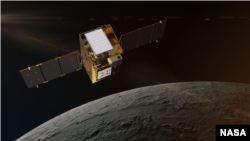The American space agency NASA is preparing to launch a spacecraft to seek more detailed information on water sources on the moon.
The spacecraft is an orbiter called Lunar Trailblazer. It is set to launch later this year, or in early 2025. A SpaceX Falcon 9 rocket will carry the orbiter to space. That rocket will also transport another moon exploring spacecraft.
In a recent statement, NASA said Lunar Trailblazer passed a series of important operational tests. It is currently completing additional software testing designed to simulate different elements of the trip, or mission.
NASA’s Jet Propulsion Laboratory (JPL) is leading the mission, in cooperation with the California Institute of Technology (Caltech) in Pasadena, California. Lockheed Martin Space provided the spacecraft, linked it with the flight system, and supports operations as part of a contract with Caltech.
The spacecraft will use two science instruments to carry out its mission. Both instruments are designed to map the moon in search of areas containing water, as well as what forms the water is in. The two instruments use infrared technology to produce highly detailed mapped images.
Lunar Trailblazer weighs about 200 kilograms and measures 3.5 meters with its solar equipment fully deployed. The spacecraft is set to orbit the moon about 100 kilometers from the lunar surface.
Several past studies have provided strong evidence that water exists on the moon. But the evidence has not included exact details on where it is and what forms it might take. Scientists believe most of the water is solid, in the form of ice. But there could be areas where water exists in liquid form, or as a gas in the atmosphere.
One study released last month suggested that existing water on the moon is more widespread than previously thought. That study was based on new examinations of data collected by India’s Chandrayaan-1 orbiting spacecraft.
NASA has said its search for water on the moon is important because it is seen as a necessary resource for future exploration activities. Astronauts could process it for drinking water, to cool equipment, to create breathable oxygen or even to make rocket fuel.
NASA said Lunar Trailblazer will make it easier for future human or robotic science investigators to use the water to see where it first came from.
For example, the presence of ammonia in ice could suggest it came from comets, NASA said. The presence of sulfur, on the other hand, could show it rose to the surface from deep inside the lunar interior when the moon was young and volcanically active.
One of the instruments, the High-resolution Volatiles and Minerals Moon Mapper, was developed by the JPL. The other, called the Lunar Thermal Mapper, was built by a team at the University of Oxford in Britain.
Neil Bowles is an instrument scientist for the Lunar Thermal Mapper. He said in a statement the instrument would center on producing detailed maps of lunar surface temperatures. He added that the other instrument will look for a series of signs, called signatures, of water molecules.
“Both instruments will allow us to understand how surface temperature affects water, improving our knowledge of the presence and distribution of these molecules on the moon,” Bowles said.
The orbiter is designed to provide scientists with new information about how much movement there is of water molecules on the moon. Such movements can be linked to how much sun specific areas receive. “Understanding whether water molecules move freely across the surface of the moon or are locked inside rock is also scientifically important,” NASA said in a statement.
Rachel Klima is an investigator for the Lunar Trailblazer spacecraft and its systems at the Johns Hopkins Applied Physics Laboratory in Laurel, Maryland.
She said data collected by the instruments can help provide information about where the moon’s water first came from. Klima compared such examinations to those involving glaciers that help scientists learn about Earth’s ancient history. Ice on the moon, she said, “could provide clues as to where that water came from and how and when it got there.”
I’m Bryan Lynn.
Bryan Lynn wrote this story for VOA Learning English, based on reports from NASA.
_________________________________________
Words in This Story
simulate – v. to do or make something that behaves or looks like something real but is not
comet – n. an object in space that leaves a bright line behind it in the sky
allow – v. to permit
distribute – v. to give something out to people or places
glacier – n. a large mass of ice that moves very slowly, usually down a hill or valley
clue – n. a sign or a piece of information that helps to solve a problem or answer a question










Forum